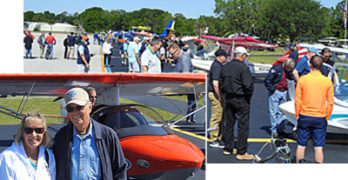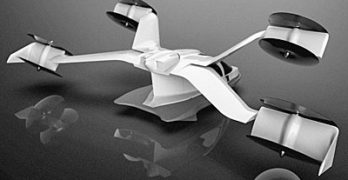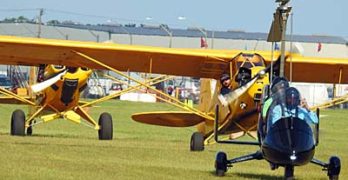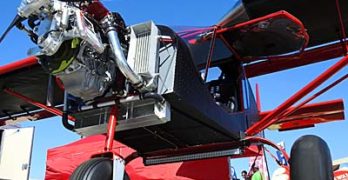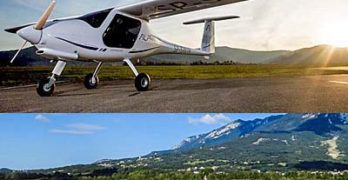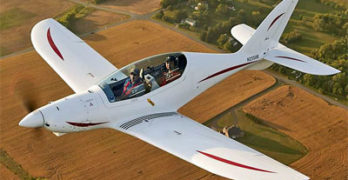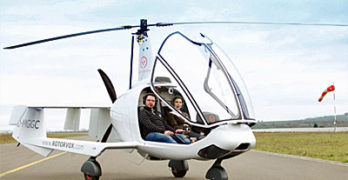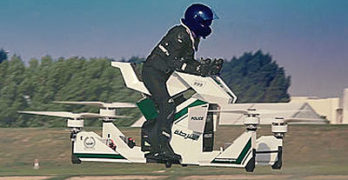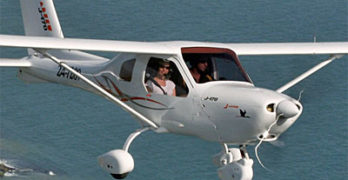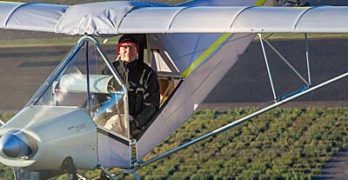Sun ‘n Fun 2018 ended a great event on Sunday. After traveling home Monday, plans called for a very quick turnaround to jet across the Atlantic for Aero Friedrichshafen 2018, which started Wednesday. For an aviation buff, the month of April is something like being a kid in a candy store.
So many fun airplanes. So few days to absorb the images, stories, people, and excitement.
Sandwiched in the 24 hours between getting home from Sun ‘n Fun and blasting off to Europe, one more cool thing happened: a gathering of LSA or light-kit seaplanes. Seven brands were invited by Spruce Creek Fly-In airport manager Joe Friend but rather ironically, two that are quartered closest to Spruce Creek — American Legend‘s AmphibCub and Brazil’s SeaMax — were unable to make it. The five who did make the effort right after Sun ‘n Fun were rewarded with a beautiful day and good interest.
Search Results for : MG 21
Not finding exactly what you expected? Try our advanced search option.
Select a manufacturer to go straight to all our content about that manufacturer.
Select an aircraft model to go straight to all our content about that model.
Weird? Or, Wonderful? More Companies Move Toward eVTOL …Will Sport Pilots?
What on Earth is going on in Airplane DesignerLand? Are we headed for a bifurcation, a parting of the ways among those engineering the next generation of aircraft? Perhaps. Will this affect you? How do you feel about non-fixed-wing aircraft?
I am searching for a term to generically describe these emerging flying machines; “drones” doesn’t quite do the job. More of these seemingly-weird-looking machines seem to pop up every day.
Prior experience suggests that most will never make it to market. Ones that do succeed in the eVTOL or electric-powered aircraft market may not even exist today. For that matter, it is far from certain that this will ever turn into a market, though given the huge amounts of money pouring into research projects, it seems nearly inevitable (to me) that some will survive and perhaps have a major impact on flying, both for transportation and for sport or recreation.
Along this vein, before and at Sun ‘n Fun 2018, I spoke to officials from BRS parachutes.
Sun ‘n Fun 2018: Records Set, Sales Made, Customers Smiling
Sun ‘n Fun 2018 is done. The show actually closed early at about 1 PM due to forecasts of severe weather. Within hours, a bustling event began to look like a ghost town.
Despite the rushed finish, the event appeared to be a huge success. Reports were that it was a all-time record result for Sun ‘n Fun; we’ll wait to see the numbers to know more detail. My conversations with several vendors indicated strong sales interest and orders were taken, so customers and vendors both appear to be satisfied.
I spoke to many fans at the show and our conversations demonstrate to me that light aviation is very alive and well. In fact, I see this as one of the most invigorated periods in recent years. The interest is broad based and includes Part 103 ultralight vehicles, gyroplanes, modestly priced Special LSA, and top-line LSA models. On the kit side, interest also appears strong enough that backlogs are growing.
Sun ‘n Fun Day 3: STOLs Will Fly Florida to Alaska (Does that Read Oddly?)
On a single day of recording several videos at Sun ‘n Fun 2018, Videoman Dave and I came across two light kit aircraft designs operating as STOL — Short Take Off and Landing — aircraft. By itself that is hardly unusual. STOL designs are plentiful and popular.
However, when you hear that two STOL-focused airplanes will be flying from Florida to Alaska, that’s something else entirely. Flying from one corner of a big country to its diagonal opposite is a fairly significant undertaking. Depending on routes chosen, this is well beyond a 4,000-mile flight. Let’s see — at 80-90 mph an hour …well, suffice it to say, that’s a lot of flying, 40+ hours, each way, would not surprise me.
Viking 180 Horse on Zenith Super Duty
At Sebring 2018 Zenith Aircraft showed their Super Duty version of their CH750 high wing, a STOL airplane equipped with a large engine and tires to match.
Pipistrel Wins Biggest Flight School Order for Alpha Trainers
One bone of contention among LSA sellers is that legacy flight schools — the sort that typically uses Cessna or Piper trainers — sometimes disregard LSA as trainer aircraft. “They’re built too lightly.” “The nose wheels are too weak.” “My mechanic doesn’t know the Rotax engine.” Some may have even more creative excuses.
I’ve interviewed many producers that are frustrated with this outdated response. Several have cited specific aircraft that have done flight school duty for thousands of hours and tens of thousands of landings.
Yet the ill-informed attitude of such school operators has not stopped sellers from trying. One such dogged entrepreneur is Michael Coates, the Australia-based largest dealer for Slovenian LSA producer, Pipistrel.
“After months and months of evaluation, writing proposals, flight tests and endless emails,” Michael wrote, “I am very proud to announce our single biggest order into the USA flight training market.”
He referenced an order for 15 Pipistrel Alpha Trainer aircraft with instrumentation configured for IFR training (photo) ordered for delivery to San Bernardino, California.
Shark in Florida! …No, the Good Kind — at Sun ‘n Fun 2018
Let me be clear. I have no issue with sharks in the sea. Besides, I don’t write about sea creatures.
This Shark is one I’ve long admired since meeting its creator, Jaro Dostal many years ago at the German airshow Aero Friedrichshafen …which will begin in mere days — we’ll be scouring the event for more fun flying machine discoveries.
Shark is represented in the USA by Jon Baron. He wrote, “We plan on flying south to Sun ‘n Fun in Lakeland, Florida and expect to arrive on Thursday, April 12th and stay for the rest of the show.”
Where can you find this handsome airplane? Well, not in a paid exhibit. Instead, “We’ll be in the General Aviation Camping Area,” indicated Jon. “If you want to meet up and check out the plane, please text me at (619) 794 7797, and I’ll send you a Google pin of our location.”
Shark Mako Coming
Shark is already a speedy, retractable gear aircraft — available in the USA only as a kit, unless you buy an already-built importer sales demonstrator.
Rotorvox C2A Gyroplane Lands in USA; Will Debut at Sun ‘n Fun 2018
Besides LSA seaplanes, one area of furious development (and sales) is gyroplanes, the term modern industry prefers to “gyrocopter,” which was actually a branded name used since the days of Igor Benson.
A new player, arriving on the scene about five years ago, is Rotorvox. Americans have not seen this aircraft but will soon get an opportunity at Sun ‘n Fun 2018 at Booth #30 in Paradise City.
Demonstration flights will occur throughout the week.
What Sets Apart Rotorvox?
Structurally, the C2A is largely carbon-fiber monocoque construction. This is notably different than the majority of smooth-looking gyroplanes. Most are steel structure with a composite pod. Rotorvox’s fuselage is also engineered to provide a protective cell for the occupants.
A few other side-by-side seating gyroplanes are on the market, including Cavalon from AutoGyro, the far and away market leader. Rotorvox’s version employs the carbon structure to provide such seating, which means it can double as a very inexpensive air ambulance.
April Foolin’? Are You Ready for Hoverbiking on Scorpion 3?
After you finish Easter Sunday dinner with the family, how about going out for a spin on your new Scorpion 3 Hoverbike? Is this merely an April fools joke?
Apparently not. Video appears to prove this machine, though with the state of the art in digital effects, anything you see can be fiction.
As many of us prepare for the start of Sun ‘n Fun 2018 in barely over one week, we hope to see numerous flying machines of interest. My visual partner, Videoman Dave and I will be onsite in Lakeland, Florida — and the following week at Aero Friedrichshafen in the south of Germany. Our mission is to collect a large batch of video that we hope will educate and entertain enthusiasts of light aviation.
I do not expect we will be covering Scorpion 3, but I have to admit I found the idea fascinating.
Guest Editorial: Why Consider Buying a Light-Sport Aircraft?
Scott Severen is an old friend and a longtime veteran of the light aircraft business. In addition to a long career with wide experience, Scott is a board member of the Light Aircraft Manufacturers Association (LAMA). Most recently, as US Sport Planes, he took over American sales of Jabiru LSA when former importer Pete Krotje reached his planned retirement date. Scott is a great choice to represent this popular set of airplanes.
As part of his role for LAMA, Scott stepped and wrote an article I think makes several good points. It follows below. —DJ
Why Buy LSA?
You have many opportunities for flying these days and the different methods to become airborne — to move through the sky — are increasing even as you are reading this.
Experience shows two reasons to fly: (1) for transportation, where the flying device is a tool and, (2) as a recreational pursuit.
Rans Celebrates 35 Years Since Coyote I with a Video Collection
Since I saw what had to be Randy Schlitter’s first appearance at Sun ‘n Fun, and since he is celebrating the 35th anniversary of the first flight of his S3 single-place Coyote I …well, we’ve been in this game for a good amount of time. And a “good time” is exactly what it has been.
The videos (linked and below) capture the company and airplane story and I believe it is best to tell the Rans and Coyote story in this way.
Nonetheless, since I’ve had the pleasure to fly nearly all Rans designs over the years, I want to say that I am pleased this company and its one-of-a-kind owner have continued to pursue light aviation.
In Randy’s own words from his Facebook page (where he is quite prolific), “This Saturday (March 17, 2018) is the 35th anniversary of the first flight of the Rans Coyote I ultralight. This craft launched Rans into the world of kit and certified planes.”
He continued about the Coyote S-3, “I still fly ole number 1 and it humbles me to do so.
- « Previous Page
- 1
- …
- 40
- 41
- 42
- 43
- 44
- …
- 94
- Next Page »


